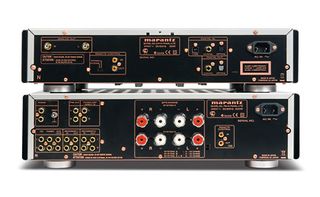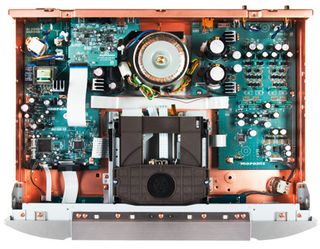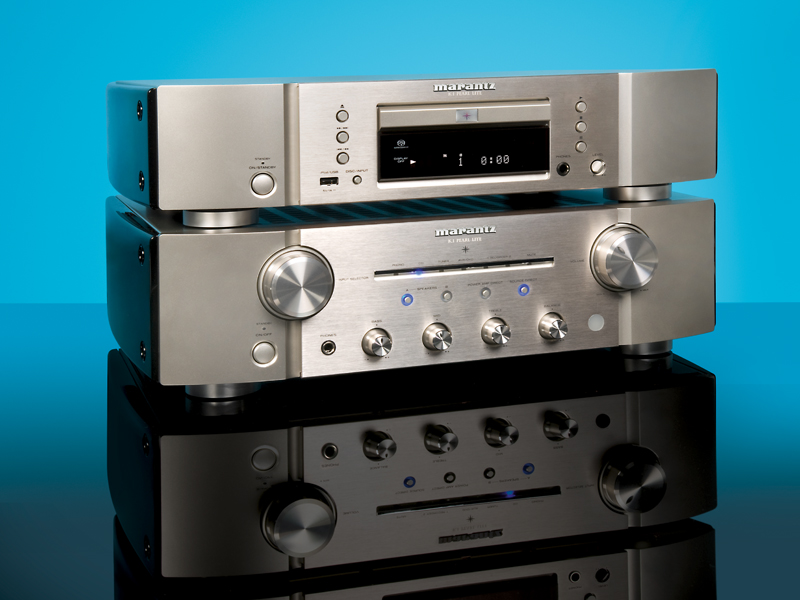TechRadar Verdict
Pros
- +
Works well together
- +
SACD playback
- +
DAC abilities
- +
Great all round ability
- +
Three band tone control
Cons
- -
Some signs of price cutting over the Pearls, (although expected)
Why you can trust TechRadar
The new Pearl 'Lites' are two of the more obvious and predictable introductions following the original Pearls, which emerged from the Marantz stable about two years ago, as a celebration of Ken Ishiwata's 30-year or so reign as the public face of Marantz.
Given the effort that reportedly went into their design, there had to be a follow-up. The Pearls were limited to a production run of 1,000 units combined for the SACD player and the amp – 500 units apiece – which even with the premium pricing they commanded probably didn't represent a pot of gold.
The obvious requirement, then was for a slightly simplified version of the two units that could be sold at a more attractive price than the Pearls, and in much larger numbers, and this is exactly what the Pearl Lites promise.
Ken was also the prime mover behind a number of other enhanced models over the years, most with an 'SE' or a 'KI' designation, derived from standard components, that were often sold alongside the regular models, or in different markets.
No lite weight
'Lite' in the context of this review means 'much more affordable', but that doesn't mean the Lites have been stripped to the bone.
The amplifier is still usefully powerful in practice (though significantly less so than the Pearl) and has a broad range of inputs including an MM phono, three line inputs and two tape circuits.
The SACD player also has a USB input on the front panel and a full set of S/PDIF and optical TOSLINK in and outputs. It can be used as a D/A converter, typically with an iPod with a digital output, or to provide a digital feed for a recorder.
We had half-anticipated that the player would lose its SACD status in the move to reduce the price, but on inserting the first disc, we noticed the familiar SACD logo near the display and breathed a sigh of relief.
In common with the regular Pearls, this is a two channel player, so any multi-channel mix is not recognised by the machine and cannot be played.
As usual, the digital outputs are disabled when playing the high-resolution layer of SACDs. The amplifier includes preamp outputs and a direct power amplifier input. Two pairs of speakers can be connected and switched independently and headphones are connected via a volume control, but the SACD player has its own headphone socket and associated volume control.

We were also amused (bemused rather) to see that the unit is equipped with not the usual two tone controls, but three – bass, midrange and treble. The reason according to Marantz is that with compressed audio media in the ascendant, something needed to be done to improve sound quality with these frequently inadequate sources.
We questioned this at first (see our interview with Ken, opposite page), but at least we can agree that it gives you another fine-tuning option and many systems may well benefit from a touch of left hand up or down on the midrange control.
Marantz hasn't completely lost its marbles here as it has included a 'source direct' switch so that the tone control stage and the balance control can be bypassed. This made quite a substantial change for the better: the sound becoming fuller and palpably more focused and less 'grainy' with the 'direct' mode engaged. But it is quite possible that stripping out the tone control circuits in their entirety would result in a further improvement in sound quality. That certainly seems to be the case historically, where a direct comparison has been possible.
Either way, the Marantz tone circuits are not completely transparent and our advice is to engage the bypass for all 'serious' listening. Both units are well made, which is practically a given with the brand, but that is not to say it compares with the original Pearls.
The controls are well-weighted and act smoothly as does the player mechanism and key construction-related features (like a dual-layer case) included for stiffness, have been retained.
The two units have a chunky, stable feel, but overall the duo are of a much lighter build and the covers, to give an example, are distinctly tinny in comparison.
Listen and you'll see
Lite by name they may be, but the newbies still wear the Ken Ishiwata KI imprimatur. The SACD player designation is SA-KI Pearl Lite and likewise for the amplifier, which is known as the PM-KI Pearl Lite.
Marantz says a number of high-quality passive components have been specified, based on its extensive listening tests – Elna Cerafine and Silmic capacitors and double-shielded transformers for example – and, as usual with the brand, the disc player has Marantz's favoured HDAM-SA2 discrete output module.

The amplifier also employs a discrete current feedback, instead of cheap and cheerful op-amps at the output. It also uses the same Xyron mechanism and the Cyrus Logic CS4398 DAC that is specified for the Pearl SACD player.
Smooth operator
The Marantz duo saw active service on test with a wide range of speakers, but the highlight of the test period was a brand new model from Triangle called Quartet. The Marantz combination proved to be a surprisingly good match, capable of driving this admittedly quite sensitive speaker, about 91dB higher than expected.
It also managed a similar feat with the much less sensitive Amphion Krypton, whereas the similarly priced Roksan M2 integrated was clearly less at ease. Somewhere in the pile of information we've accumulated on the Lites, Marantz makes the suggestion that the Lites are balanced to sound a little warmer than usual through the mid and upper frequency band.
We don't want to make too much of this, because there is no way the sound of this combination could be described as tonally dull or lacking in detail, because neither is true, but there is a subtle loss of the excessive sharpness, the exaggerated sense of detail that is often a part of contemporary amplifier design and the result is almost valve-like, but in a positive sense.
The disc player is simply excellent, and in keeping with the amplifier, creates a combination that is easy on the ear, with expansive, stable imagery, and a very open kind of voicing that makes for easy and consistent longterm listening.
Pearl and sheen
Voicing is a particularly good word in this context, as voices in particular are handled with real grace and passion (examples include Jan Chaplin (Songs of Stevie Wonder) on SACD and Christianne Stotijn (Mezzo Soprano) in Brahms Alto Rhapsody on CD, both of which were reproduced with an unusual sweetness and flair.
Understandably, the Lites don't quite have the weight of the Pearls, but in combination they are, indeed, a great stereo package.
Follow TechRadar Reviews on Twitter: http://twitter.com/techradarreview

